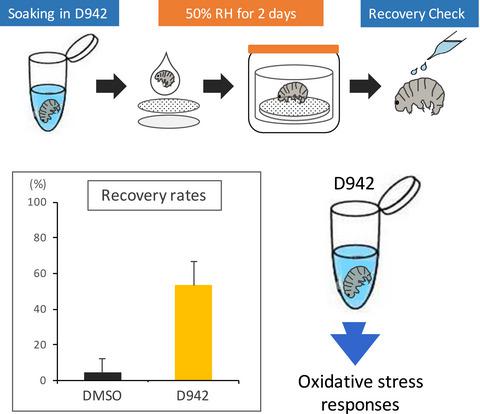当前位置:
X-MOL 学术
›
FEBS Open Bio
›
论文详情
Our official English website, www.x-mol.net, welcomes your feedback! (Note: you will need to create a separate account there.)
Pre-treatment with D942, a furancarboxylic acid derivative, increases desiccation tolerance in an anhydrobiotic tardigrade Hypsibius exemplaris.
FEBS Open Bio ( IF 2.6 ) Pub Date : 2020-07-22 , DOI: 10.1002/2211-5463.12926 Koyuki Kondo 1 , Masaru Mori 1, 2 , Masaru Tomita 1, 2 , Kazuharu Arakawa 1, 2, 3
FEBS Open Bio ( IF 2.6 ) Pub Date : 2020-07-22 , DOI: 10.1002/2211-5463.12926 Koyuki Kondo 1 , Masaru Mori 1, 2 , Masaru Tomita 1, 2 , Kazuharu Arakawa 1, 2, 3
Affiliation

|
The tardigrade Hypsibius exemplaris can undergo anhydrobiosis. Several chemicals that inhibit successful anhydrobiosis in H. exemplaris have been identified, and these chemicals inhibit the activity of signaling molecules. In the present study, we investigated whether upregulation of the activity of these signaling molecules could improve desiccation tolerance of H. exemplaris. Pre‐treatment with an indirect activator of AMP‐activated protein kinase [AMPK; which directly inhibits mammalian NAD(P)H dehydrogenase [quinone] 1 [NQO1] of mitochondrial complex I (D942)] significantly improved desiccation tolerance of H. exemplaris, whereas a direct activator of AMPK did not. To elucidate the underlying molecular mechanisms, we examined the proteome of tardigrades treated with D942. Two proteins, putative glutathione S‐transferase and pirin‐like protein, were upregulated by treatment. Both of these proteins are known to be associated with the response to oxidative stress. One of the downregulated proteins was serine/threonine‐proteinphosphatase 2A (PP2A) 65‐kDa regulatory subunit A alpha isoform, and it is interesting to note that PP2A activity was previously suggested to be required for successful anhydrobiosis in H. exemplaris. Taken together, our results suggest that D942 treatment may partially induce responses common to those of desiccation stress. The identification of a chemical that improves desiccation tolerance of H. exemplaris may facilitate further investigation into desiccation tolerance mechanisms.
中文翻译:

用 D942(一种呋喃甲酸衍生物)进行预处理可提高无水生物缓步动物 Hypsibius 范例的干燥耐受性。
缓步动物Hypsibius exemplaris可以进行脱水。已经鉴定了几种抑制H. exemplaris成功脱水的化学物质,这些化学物质抑制信号分子的活性。在本研究中,我们研究了这些信号分子活性的上调是否可以提高H. exemplaris 的干燥耐受性。用 AMP 活化蛋白激酶 [AMPK; 的间接激活剂进行预处理;直接抑制线粒体复合物 I (D942) 的哺乳动物 NAD(P)H 脱氢酶 [醌] 1 [NQO1]] 显着提高了H. exemplaris 的干燥耐受性,而 AMPK 的直接激活剂则没有。为了阐明潜在的分子机制,我们检查了用 D942 处理的缓步动物的蛋白质组。两种蛋白质,推定的谷胱甘肽S转移酶和 pirin 样蛋白,通过治疗上调。已知这两种蛋白质都与对氧化应激的反应有关。下调的蛋白质之一是丝氨酸/苏氨酸-蛋白磷酸酶 2A (PP2A) 65-kDa 调节亚基 A α 同种型,有趣的是,以前认为 PP2A 活性是H. exemplaris 中成功脱水生化所必需的. 总之,我们的结果表明 D942 处理可能会部分诱导干燥应激常见的反应。鉴定提高H. exemplaris干燥耐受性的化学物质可能有助于进一步研究干燥耐受机制。
更新日期:2020-07-22
中文翻译:

用 D942(一种呋喃甲酸衍生物)进行预处理可提高无水生物缓步动物 Hypsibius 范例的干燥耐受性。
缓步动物Hypsibius exemplaris可以进行脱水。已经鉴定了几种抑制H. exemplaris成功脱水的化学物质,这些化学物质抑制信号分子的活性。在本研究中,我们研究了这些信号分子活性的上调是否可以提高H. exemplaris 的干燥耐受性。用 AMP 活化蛋白激酶 [AMPK; 的间接激活剂进行预处理;直接抑制线粒体复合物 I (D942) 的哺乳动物 NAD(P)H 脱氢酶 [醌] 1 [NQO1]] 显着提高了H. exemplaris 的干燥耐受性,而 AMPK 的直接激活剂则没有。为了阐明潜在的分子机制,我们检查了用 D942 处理的缓步动物的蛋白质组。两种蛋白质,推定的谷胱甘肽S转移酶和 pirin 样蛋白,通过治疗上调。已知这两种蛋白质都与对氧化应激的反应有关。下调的蛋白质之一是丝氨酸/苏氨酸-蛋白磷酸酶 2A (PP2A) 65-kDa 调节亚基 A α 同种型,有趣的是,以前认为 PP2A 活性是H. exemplaris 中成功脱水生化所必需的. 总之,我们的结果表明 D942 处理可能会部分诱导干燥应激常见的反应。鉴定提高H. exemplaris干燥耐受性的化学物质可能有助于进一步研究干燥耐受机制。



























 京公网安备 11010802027423号
京公网安备 11010802027423号